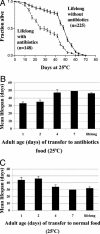Drosophila lifespan enhancement by exogenous bacteria
- PMID: 15322271
- PMCID: PMC516503
- DOI: 10.1073/pnas.0405207101
Drosophila lifespan enhancement by exogenous bacteria
Abstract
We researched the lifespan of Drosophila under axenic conditions compared with customary procedure. The experiments revealed that the presence of bacteria during the first week of adult life can enhance lifespan, despite unchanged food intake. Later in life, the presence of bacteria can reduce lifespan. Certain long-lived mutants react in different ways, indicating an interplay between bacteria and longevity-enhancing genes.
Copyright 2004 The National Academy of Sciencs of the USA
Figures





References
-
- McFall-Ngai, M. J. (2002) Dev. Biol. 242, 1–14. - PubMed
Publication types
MeSH terms
Substances
LinkOut - more resources
Full Text Sources
Other Literature Sources
Molecular Biology Databases

